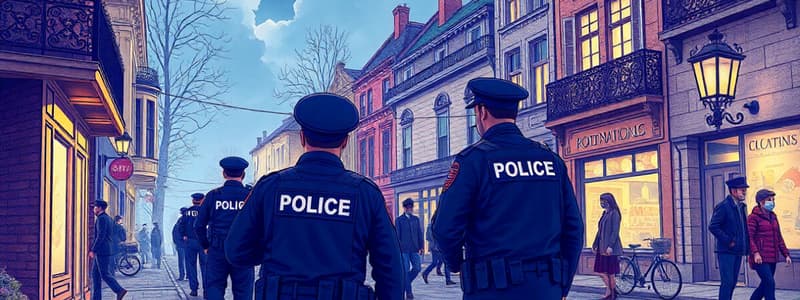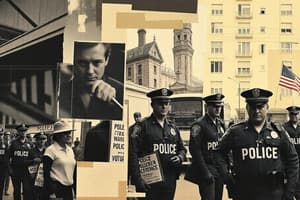Podcast
Questions and Answers
The Broken Windows Theory suggests that addressing even minor offenses like graffiti can help prevent more serious crimes.
The Broken Windows Theory suggests that addressing even minor offenses like graffiti can help prevent more serious crimes.
True (A)
Social Disorganization Theory states that crime is primarily caused by individual factors, such as personality traits or past experiences.
Social Disorganization Theory states that crime is primarily caused by individual factors, such as personality traits or past experiences.
False (B)
Broken Windows Theory argues that neglecting minor crimes leads to an escalation of criminal activity, much like a snowball effect.
Broken Windows Theory argues that neglecting minor crimes leads to an escalation of criminal activity, much like a snowball effect.
True (A)
Both Social Disorganization Theory and Broken Windows Theory suggest that addressing community-level issues is key to crime prevention.
Both Social Disorganization Theory and Broken Windows Theory suggest that addressing community-level issues is key to crime prevention.
According to Broken Windows Theory, the presence of order maintenance policing is irrelevant to the overall crime rate.
According to Broken Windows Theory, the presence of order maintenance policing is irrelevant to the overall crime rate.
Social Disorganization Theory emphasizes the idea that strong social ties and a sense of collective efficacy within a community can prevent crime.
Social Disorganization Theory emphasizes the idea that strong social ties and a sense of collective efficacy within a community can prevent crime.
Broken Windows Theory is a highly controversial theory, with many critics challenging its assumptions and empirical support.
Broken Windows Theory is a highly controversial theory, with many critics challenging its assumptions and empirical support.
Social Disorganization Theory suggests that neighborhoods with high levels of poverty and residential instability tend to have lower crime rates.
Social Disorganization Theory suggests that neighborhoods with high levels of poverty and residential instability tend to have lower crime rates.
The Broken Windows Theory emphasizes the importance of promoting community awareness and vigilance to reduce fear of crime.
The Broken Windows Theory emphasizes the importance of promoting community awareness and vigilance to reduce fear of crime.
Social Disorganization Theory states that crime is a result of individual factors, such as lack of education or employment opportunities.
Social Disorganization Theory states that crime is a result of individual factors, such as lack of education or employment opportunities.
Flashcards
Community Oriented Policing (COP)
Community Oriented Policing (COP)
A policing strategy focusing on building relationships with the community to solve problems proactively.
Problem-Oriented Policing (POP)
Problem-Oriented Policing (POP)
A proactive approach that targets root causes of crime through analysis and problem-solving.
Broken Windows Theory
Broken Windows Theory
Theory suggesting visible disorder causes further crime; small issues should be addressed quickly.
Social Disorganization Theory
Social Disorganization Theory
Signup and view all the flashcards
Proactive Problem-Solving
Proactive Problem-Solving
Signup and view all the flashcards
Public Trust in Policing
Public Trust in Policing
Signup and view all the flashcards
Community Meetings
Community Meetings
Signup and view all the flashcards
Data Analysis in Policing
Data Analysis in Policing
Signup and view all the flashcards
Minor Offenses and Crime Prevention
Minor Offenses and Crime Prevention
Signup and view all the flashcards
Community Stakeholders
Community Stakeholders
Signup and view all the flashcards
Study Notes
Community Oriented Policing (COP)
- Emphasizes building relationships between police and the community.
- Focuses on proactive problem-solving, rather than reactive crime fighting.
- Involves community members in identifying and addressing problems.
- Aims to improve police legitimacy and public trust.
- Often involves community meetings, partnerships with local organizations, and initiatives designed to improve neighborhoods.
- Relies on trust and communication as foundations for a successful strategy.
- Often aims to reduce fear of crime by promoting community vigilance and awareness.
Problem-Oriented Policing (POP)
- A proactive approach to policing that targets the root causes of crime problems.
- Involves identifying, analyzing, and responding to particular problems.
- Focuses on preventing crime, not just reacting to it.
- Emphasizes data analysis and problem-solving strategies.
- Involves officers working with community stakeholders in identifying and addressing issues.
- Critically examines the nature of the problem presented before suggesting a solution.
- Often incorporates community meetings and data analysis to develop solutions.
Broken Windows Theory
- Suggests that visible signs of disorder (like broken windows) create an environment conducive to further crime and disorder.
- Argues that ignoring minor offenses can lead to a snowball effect.
- Emphasizes the importance of addressing minor issues quickly to maintain a sense of order in a neighborhood.
- Presents the idea that minor infractions of social and physical order can lead to major crimes.
- Provides a theoretical framework to understand how visible disorder can affect public safety.
- Not universally accepted; its implications about causality and intervention are under debate.
- A core component is the notion of order maintenance as a police function.
Social Disorganization Theory
- Explains crime rates based on the characteristics of a community, rather than individual characteristics.
- Postulates that crime is more likely to occur in neighborhoods lacking social cohesion and informal social control.
- Highlights factors like poverty, residential instability, and diversity in explaining crime patterns.
- Explores how weak social ties and lack of shared values within a community can contribute to crime.
- Focuses on community-level characteristics, such as limited resources, lack of collective efficacy, and weak social networks.
- Argues that such conditions impede effective social control mechanisms and lead to higher crime rates.
- Emphasizes the importance of building strong social networks and community organizations in reducing crime rates.
- Links community characteristics to crime patterns, arguing that impoverished, unstable, or highly segregated communities are more prone to crime.
- This theory suggests that interventions aimed at strengthening community structures and relationships are a necessary response for effective crime prevention.
Studying That Suits You
Use AI to generate personalized quizzes and flashcards to suit your learning preferences.




